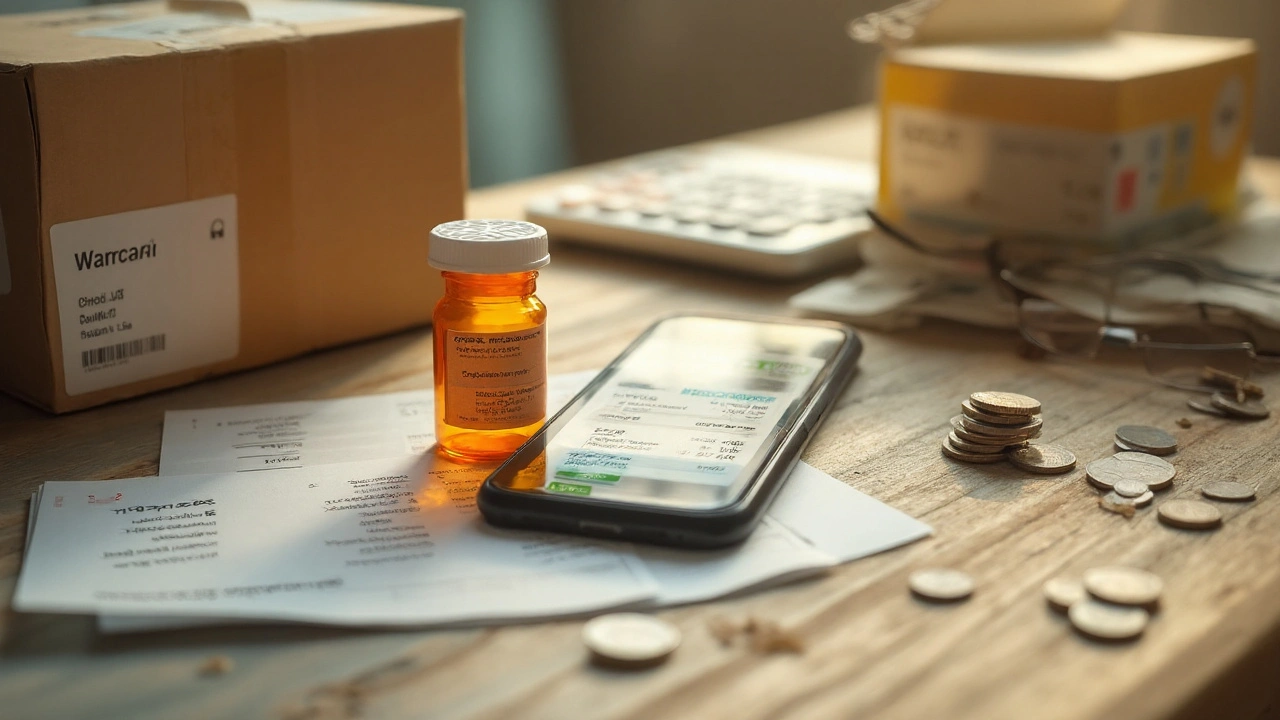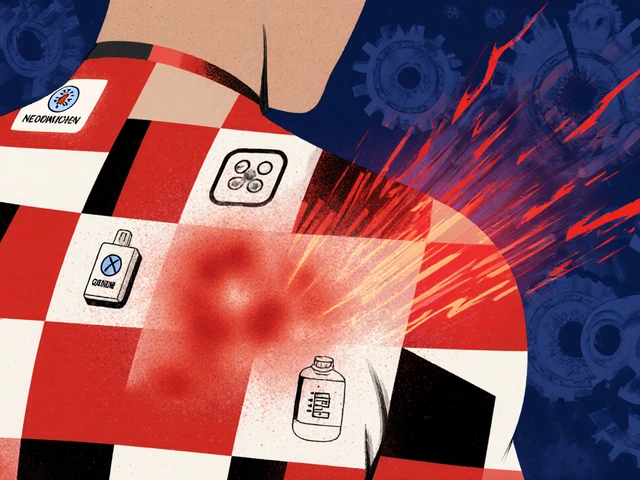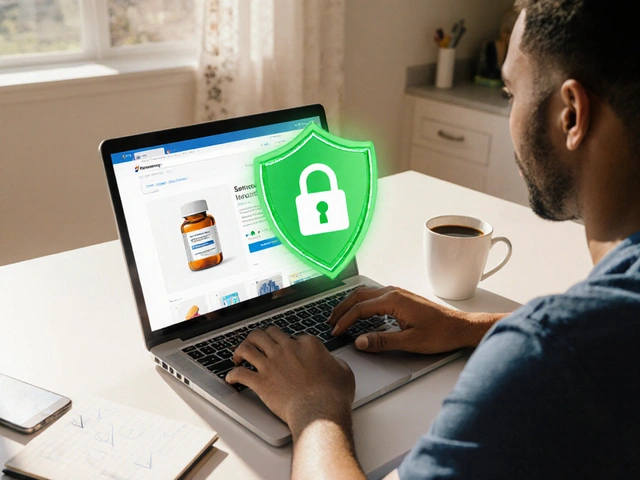You’re here to pay less for warfarin without gambling on your health. Fair. Warfarin is a narrow-therapeutic-index drug, so a sketchy pharmacy is not just a bad deal-it’s dangerous. I’ll show you how to get a low price from legitimate sources, what a safe checkout looks like, and the warfarin-specific rules you should never skip (INR testing, interactions, the whole package). Expect realistic price ranges for 2025 in the U.S., a step-by-step playbook, and clear signals that a site is legit. I live in Seattle, and this is how I’d help a family member set this up from scratch.
What you can and can’t do when you want cheap generic warfarin online
Let’s set ground rules. Warfarin is prescription-only in the U.S. You’ll need a valid prescription from a licensed clinician. Any website offering warfarin with “no prescription” or shipping from unknown locations is a hard no. The FDA and the National Association of Boards of Pharmacy (NABP) say the same. Counterfeits and wrong strengths aren’t rare-they’re the point of those sites.
Legit online pharmacies are state-licensed, require a prescription, have a U.S. address (visible on their site), list a U.S. phone number staffed by pharmacists, and use secure checkout. Many also hold NABP .pharmacy accreditation or appear on the NABP “Buy Safe Rx” list. LegitScript-certified is another good sign. If you can’t verify licensing with your state board of pharmacy, walk away.
What you can do online safely:
- Order your refill from a U.S.-licensed mail-order pharmacy or a big-box retailer’s online portal.
- Use price tools to compare cash prices and apply coupons at checkout.
- Use telehealth to get a legitimate prescription if you’re not yet established (warfarin isn’t a controlled substance).
- Set up 90-day supplies to cut per-tablet cost and reduce copays.
What you shouldn’t do:
- Buy from any site that sells without a prescription or hides contact info.
- Import unapproved versions from overseas. U.S. law is strict here, and quality control is the risk you don’t want with an anticoagulant.
- Switch tablet strengths or manufacturers without checking your dosing plan and scheduling an INR check.
Quick reminder on why risk management matters: warfarin dosing is individualized to your INR goal (2.0-3.0 for most indications; 2.5-3.5 for some mechanical valves). Changes in diet, antibiotics, supplements, or tablet strength can push you out of range and raise clotting or bleeding risk. The FDA Medication Guide and CHEST guidelines hammer this home. I’m not your doctor, but these basics save headaches.
How to buy generic warfarin online safely: a step-by-step playbook
Here’s the clean, repeatable process I use when helping someone set this up.
- Confirm your prescription details. Warfarin prescriptions include strength (1 mg, 2 mg, 2.5 mg, 3 mg, 4 mg, 5 mg, 6 mg, 7.5 mg, or 10 mg), dosing schedule (often varies by day), quantity, and refills. If your dosing changes often, ask your prescriber for multiple strengths or a 5 mg base with split-tablet instructions so you can adjust safely under guidance.
- Pick your pharmacy type.
- Mail-order: Good for 90-day fills, usually the lowest per-tablet price. Many insurers offer in-network mail-order.
- Big-box or grocery chains: Often have robust online portals and same-week pickup or ship-to-home.
- Independent pharmacies: Great service; some now ship regionally and will price-match.
- Verify legitimacy. Check state licensure on your state Board of Pharmacy site. Look for NABP .pharmacy or Buy Safe Rx status or LegitScript certification. Confirm there’s a U.S. pharmacist phone line. No verification, no order.
- Send the prescription. Ask your clinic to e-prescribe directly. If you must upload, use the pharmacy’s secure portal. Telehealth is fine for initiating, but make sure you have a plan for INR tests (local lab, clinic, or home INR monitor).
- Compare prices before you pay. Check cash price vs. your insurance copay. If cash is cheaper, you can pay cash and not use insurance for that fill. Apply a coupon if the pharmacy accepts it. For mail-order, 90-day fills often win.
- Place the order with guardrails. Choose trackable shipping. Set refill reminders for 10-14 days before you run out. If you’re close to a dose change or switching manufacturers, schedule an INR check 3-7 days after the switch.
- On delivery: safety check. Confirm the manufacturer, strength, imprint, and pill color. Warfarin tablets are color-coded by strength, but colors vary by manufacturer. Use the NDC/label to verify. If anything differs from your last fill, call the pharmacist before taking it.
Pro tip: keep a simple dosing calendar. A lot of people use a 7-day pill organizer and a phone reminder. That little habit prevents the most common mistakes (double-dosing, missed days, grabbing the wrong strength).
Realistic 2025 prices and how to pay less without cutting corners
Warfarin is one of the cheaper long-term meds when you buy smart. Prices below are typical cash ranges I’ve seen across large U.S. chains and mail-order in 2025. Your exact price depends on pharmacy, quantity, coupons, and strength.
| Form/Strength | Typical Qty | Cash Price Range (USD) | Notes |
|---|---|---|---|
| Warfarin 1 mg-4 mg | 30 tablets | $4-$12 | Lower strengths sometimes cost a bit more per tablet. |
| Warfarin 5 mg | 30 tablets | $3-$10 | Common base strength; often the cheapest per tablet. |
| Warfarin 6-10 mg | 30 tablets | $5-$15 | Heavier strengths can vary more by manufacturer. |
| Any strength | 90 tablets | $8-$25 | 90-day supply usually drops unit cost by 20-50%. |
| Mail-order (in-network) | 90 tablets | $0-$15 copay | Many plans set low tier copays for warfarin. |
Ways to bring your price down even more:
- 90-day fills: The easiest win. Ask your prescriber to write 90-day with refills.
- Use your plan’s preferred mail-order: Often $0-$10 for a 90-day supply.
- Cash price + coupon: Sometimes beats insurance. You can choose cash for warfarin and use insurance for other meds.
- Manufacturer isn’t precious here: Generic warfarin sodium must meet FDA standards. Stick to a manufacturer, but you don’t need “brand” to be safe-just be consistent and check INR after any switch.
- Medicare Part D (2025): There’s a $2,000 annual cap across meds this year. Warfarin alone won’t get you near it, but it’s good budget news if you take multiple drugs.
Shipping and timing tips:
- Standard shipping: 3-7 business days. Upgrade if you’re within a week of running out.
- Set auto-refill, but keep control: auto-refill + manual reminder 14 days before you run out.
- Traveling? Ask for a vacation override for an extra fill. Keep meds in your carry-on.
Risks to manage with warfarin and online ordering
You can get a great price and still mess up safety. Here’s the short list I keep on my fridge for people on warfarin.
- INR monitoring is non-negotiable. Most folks target 2.0-3.0; some mechanical valves target 2.5-3.5. Start/stop antibiotics, new supplements, or diet swings? You may need an extra INR. The FDA Medication Guide and CHEST guidance back this up.
- Tablet mix-ups. Warfarin is color-coded by strength, but colors vary by manufacturer. Always check imprint and NDC. If the pill looks different, confirm before taking.
- Diet consistency over perfection. Vitamin K (leafy greens) is not “forbidden.” Keep intake consistent. Big swings change your INR.
- Common interaction traps. High-risk: antibiotics (like TMP-SMX, metronidazole), amiodarone, many antifungals, NSAIDs, aspirin, alcohol binges, herbal products (St. John’s wort decreases effect; ginkgo/garlic can increase bleeding risk). New med? Ask your pharmacist or clinician and schedule an INR.
- Manufacturer switch = check INR. Pharmacies sometimes switch suppliers. When that happens, plan an INR within about a week.
- Shipping delays. Order when you have at least 10-14 days left. If you’re down to fewer than 5 days and the package is late, call the pharmacy for a short local fill.
- Emergency cues. Unusual bruising, blood in stool/urine, severe headache, or injury with bleeding-seek care now. Don’t wait for a portal message.
Quick warfarin dosing and safety cheat sheet:
- Common tablet strengths: 1 mg (pink), 2 mg (purple), 2.5 mg (green), 3 mg (tan), 4 mg (blue), 5 mg (peach), 6 mg (teal), 7.5 mg (yellow), 10 mg (white) - colors vary by manufacturer; the imprint is your guide.
- Half-life: roughly 36-42 hours; dose changes take a few days to show in the INR.
- Missed dose: If you remember the same day, take it. If it’s the next day, skip and resume. Don’t double up without clinician advice.
- Alcohol: keep it light and consistent. Binge drinking spikes bleeding risk.
Authoritative sources you can trust on these points: FDA Medication Guide for warfarin, American College of Chest Physicians (CHEST) antithrombotic therapy guidelines, and American Heart Association/American College of Cardiology/HRS atrial fibrillation guideline recommendations.

Alternatives, substitutions, and when to switch (or not)
People ask, “Should I just switch to a DOAC like apixaban?” Sometimes yes, sometimes no.
- DOACs (apixaban, rivaroxaban, dabigatran, edoxaban)
- Pros: No routine INR checks, fewer food interactions, predictable dosing.
- Cons: Higher price, not for mechanical valves or moderate-severe mitral stenosis, dosing depends on kidney function and drug interactions.
- Cost reality in 2025: $400-$600/month cash before coupons; many plans cover with tiered copays. Assistance programs exist, but hoops apply.
- When warfarin is better: Mechanical heart valves, certain thrombophilias, cost is a key barrier, or you’re already stable with good time-in-therapeutic-range.
- If you do switch: Follow your clinician’s transition plan (there are well-defined timing rules by drug), and never overlap casually. ACC/AHA and CHEST publish these schedules.
- Bridging with LMWH: Only if your clinician tells you. Don’t self-bridge because a package is late.
- Different manufacturers of warfarin: Fine, but document the new NDC, verify pill imprint, and check an INR after the switch.
One more angle: If your insurance offers a $0 copay for DOACs under a special program, do the math with your clinician. For some, the time saved from INR checks is worth it. For others, warfarin at a few dollars a month is the right call. I’ve watched both paths work well.
Clean checklists, quick comparisons, and the safe checkout model
Use these to keep things tight.
Legit online pharmacy checklist
- Requires a valid prescription
- Lists U.S. address and pharmacist phone number
- State-licensed (confirmed on your state board website)
- NABP .pharmacy, Buy Safe Rx, or LegitScript status
- Secure checkout (https), clear privacy policy
- No “miracle discounts,” no spammy upsells, no “no prescription needed” claims
Price-cutting playbook (fast)
- Ask for a 90-day prescription with refills.
- Check cash price vs. your copay.
- Apply a coupon if cash beats your copay.
- Choose trackable shipping; order with 10-14 days cushion.
- Set an INR check after any manufacturer switch.
Safe checkout flow (what you should see)
- Account setup with your full name, DOB, and address (matches Rx)
- Clinician info for e-Rx or secure Rx upload
- Drug selection by strength and quantity that matches your Rx
- Drug interaction screen and optional pharmacist consult
- Shipping options with tracking + delivery estimate
- Transparent price before you pay; taxes and fees shown
- Order confirmation with an Rx number and pharmacist contact
Mini-FAQ
Is it legal to buy warfarin online?
Yes-if it’s from a U.S.-licensed pharmacy that requires a prescription. Avoid any site that skips the prescription.
How cheap can it get?
Cash prices for a 90-day supply often land between $8 and $25 in 2025. With insurance, many pay $0-$15.
Do colors mean anything?
Yes, colors loosely map to strengths, but they vary by manufacturer. Always confirm the imprint/NDC, not just color.
Can I switch between brand and generic?
Yes, but notify your care team and check an INR after the switch. The FDA and CHEST both support monitoring with any manufacturer change.
What if I run out and my shipment is late?
Call the pharmacy for a local short fill and alert your clinic. Don’t skip doses or double up later.
Can telehealth prescribe warfarin?
Yes. It’s not a controlled substance. Make sure you have a plan for INR tests (lab, clinic, or home monitor).
Next steps and troubleshooting for your situation
If you’re uninsured
- Go for 90-day cash fills at high-volume chains or mail-order. Use coupons.
- Ask about independent pharmacy price-matching. Many will match large chains.
- Save on labs: community clinics and some hospital labs offer discounted INR testing.
If you’re on Medicare
- Use your Part D plan’s preferred mail-order for the lowest copay.
- 2025’s $2,000 cap helps if you take multiple meds, even if warfarin is already cheap.
If you’re insured with a high-deductible plan
- Compare cash + coupon vs. plan price. Often cash wins for warfarin.
- Still submit receipts for potential HSA reimbursement.
If your pharmacy changed manufacturers
- Verify new tablet imprint and strength.
- Schedule an INR within 3-7 days after the switch.
- If you feel off (bruising, nosebleeds, headaches), call your clinician sooner.
If your dose changes often
- Ask for multiple strengths or scored tablets to simplify small adjustments.
- Keep a written dosing calendar. Avoid mental math.
If you travel or move
- Use a national pharmacy chain or a mail-order that ships to your new address.
- Carry at least one extra week of pills and a current printed prescription list.
- Line up an INR lab near your destination before you go.
If you’re new to warfarin
- Expect more frequent INRs at first. It settles down once you’re stable.
- Keep diet steady, especially leafy greens. No need to avoid them-be consistent.
- Tell every clinician and dentist you’re on warfarin. Wear a medical alert bracelet if you like redundancy (I do).
Ethical next step if you want the lowest safe price today: choose a U.S.-licensed, NABP-recognized pharmacy that requires your prescription, ask your prescriber for a 90-day supply, compare cash vs. copay, and set an INR check after any manufacturer change. That’s the playbook I follow for my own family. My wife Aisling would tell you I’m annoyingly meticulous about pill imprints-but with warfarin, that’s a feature, not a bug.
Sources I trust for the guidance above: FDA Medication Guide for warfarin; American College of Chest Physicians antithrombotic therapy guidelines; American Heart Association/American College of Cardiology/HRS atrial fibrillation guidelines; National Association of Boards of Pharmacy “Buy Safe Rx.” They all point to the same core message: buy from licensed pharmacies, use consistent dosing, monitor your INR, and treat big discounts with big skepticism.






Check the state board license first and don’t skip the pharmacist phone call - that single sanity check catches most scams.
Prescription-only meds need paperwork that matches the shipping address and the pharmacy’s listed pharmacist; if anything is fuzzy, stop the order right there. Keep a photo of your last bottle so you can compare imprints and NDCs when the new pack shows up. If a site pressure-sells ridiculous coupons or claims "no script needed," walk away and report it to the NABP. Also, keep a paper or digital dosing calendar; that small habit prevents the dumb mistakes that make people end up in ERs.
August 22Wanda Smith